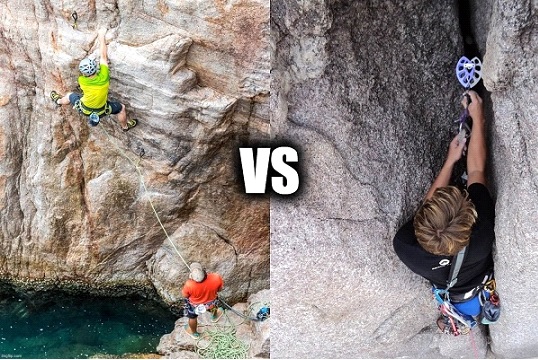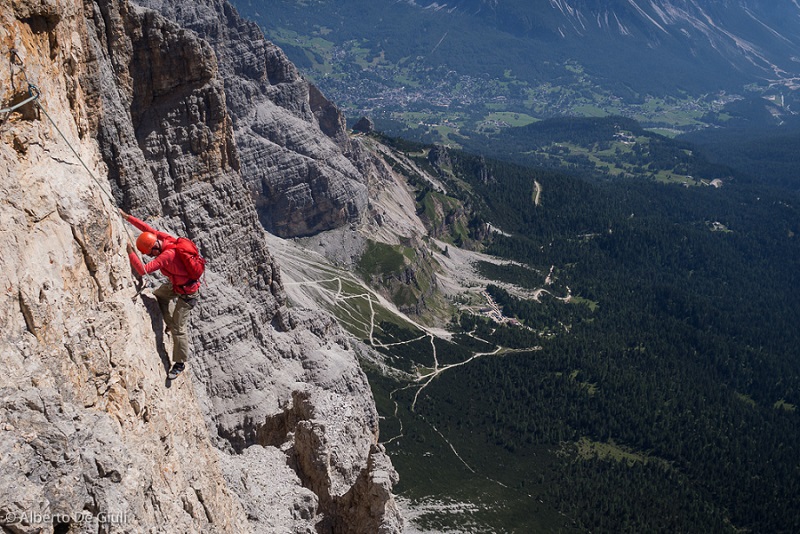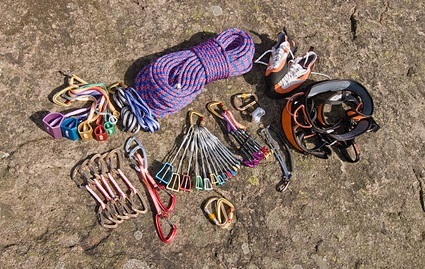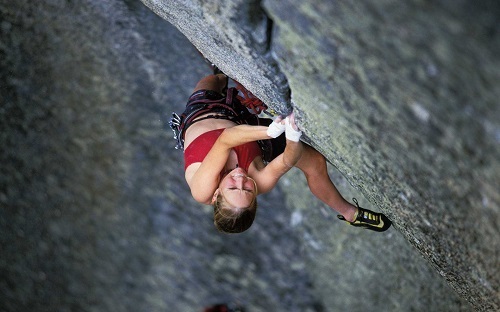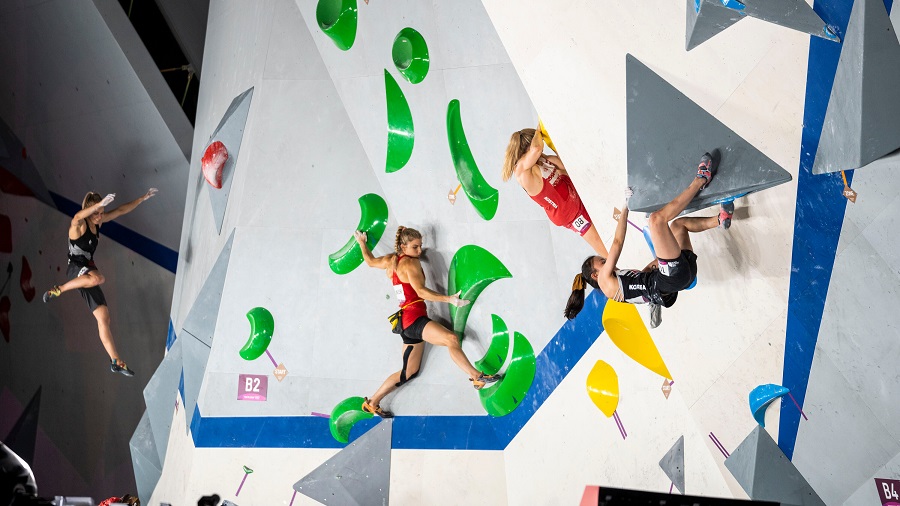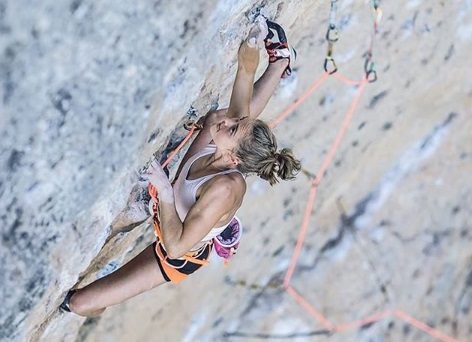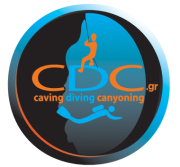Climbing has been around for many years now, and is getting extremely popular as it recently became an Olympic sport. You see men and women in incredible physical condition doing the unthinkable. Climbing vertical walls, even overhangs, conquering their fears, doing incredible movements and jumps on the rock, hanging upside down, holding on to tiny or slippery grips, while literally hanging by a thread! At the same time equipment is getting smaller and lighter, such as harnesses, ropes, quickdraws, helmets etc. But climbing wasn’t always like that.
When people first started to rock climb for recreational purposes, back in the 1800, there were no readymade routes, no bolts, no guarantied safety. People had to carry their own equipment (which was much heavier than today), and use it wisely. But most of all they had to use their mind. They had to study the rock well and figure out a route along the way. This was the beginning of “trad” (traditional) climbing. It took many years before people started rappelling down from the top, carrying electric drills and placing bolts on the wall, establishing a route for what came to be known as “sport” climbing somewhere in the 80’s.
In this article we will explore these two basic styles of climbing (we’ll discuss bouldering in another article) and get into their main differences, their advantages and their difficulties.
Trad Climbing
Trad climbing means old school climbing. Trad climbing means freedom, as there is no pre-established route for you to follow. If you see a rock wall anywhere in the world, you are free to give it a go as long it has features you can use to anchor yourself. Experience is quite important as you need to study the wall, its formation, its features, its quality, its cracks and holes, to determine where and how you are going to climb, what sort of equipment you’re going to need and how long it might take you. It requires extraordinary focus as it is an incredible mind game. There is no safety guarantied, you are solely responsible for your choices and your possible mistakes. So it’s a serious game for serious players.
The basic idea is that as a lead climber (who climbs first) you use special equipment (like cams and nuts) to place on the way in small or large cracks you find along the route to create your own safety anchors. That means you’ll have to examine the rock pretty well and calculate which type of gear will best fit in the specific crack. Once you place the gear you’ll have to test it by pulling it down and ask yourself “is this going to hold?” The most honest answer is “I hope so”!

Since there is no safety guaranty –as you won’t know if you placed the gear correctly until you fall- falling is something you generally avoid as much as possible. That means mindful climbing. Trad climbing is not the place to hurry or try crazy moves on the rock. It’s about taking the next small step. You need good concentration and good physical endurance as you may not find a suitable feature on the rock to secure from for some time. It’s good to get a booklet about the rock area you want to climb – if there is one- so you can read about other people’s suggestions on the type of gear you will most likely need. Still, you are always heading into the unknown so you need to be extra prepared with sufficient gear.
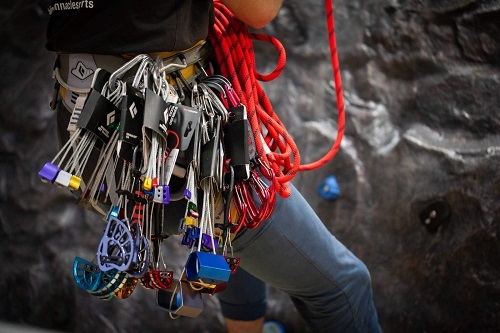
Trad climbing means you’ll be carrying a heavy load. Different types of equipment in different sizes, a number of nuts, cams, quickdraws, carabiners, slings, and climbing ropes, as well as a nut tool to remove the gear from the rock when your partner is climbing “top rope” after you, collecting all of the equipment. The basic idea is that you don’t leave anything on the rock. For some people trad climbing is considered more environmental friendly for this reason, comparing to sport climbing which has permanent bolts on the rock.
Since trad climbing requires a large set of climbing equipment it means the cost of obtaining all this gear is quite high. You’ll need to slowly build your collection of equipment and definitely take good care of it!
Trad climbers use sport climbing outdoors or in the gym to practice their moves and endurance so since sport climbing came around there has been a tremendous increase in level of difficulty. Nowadays the hardest routes in trad climbing reach up to 5.14d/5.15a (we discuss climbing grades in another article). Some of the world’s most famous trad climbers are Jacopo Larcher , Pete Whittaker and Tom Randall, Beth Rodden, Tommy Caldwell, and Sonnie Trotter.
Some of the hardest trad routes today are
Tribe, 5.14d / 9a, Cardarese, Italy, FA Jacopo Larcher
Meltdown, 5.14c / 8c+, California, USA, FA Beth Rodden
Pura Pura, 5.14c / 8c+, Valle dell’Orco, Italy, FA Tom Randall
Cobra Crack, 5.14b/c / 8c+, Squamish, Canada, FA Sonnie Trotter
Photo: Beth Rodden / Meltdown
Sport Climbing
Sport climbing started gaining popularity in the 80’s as it made it possible to climb walls which were otherwise impossible to climb. Drilled bolts in the wall means you’re as secure as you can be, which makes it possible to test yourself to the limits not fearing the fall. The possibility of a bolt failing is extremely low if the job was done right by experienced hands so it’s pretty safe to fall –as long as you have a helmet on and some basic experience in falling. Training at a climbing gym is a great way to practice new moves and falling.
Lead sport climbing requires only enough quickdraws for the route which are predefined as there is a pre-known number of bolts on the route. That means you’ll be carrying a lot less weight which makes it easier to climb and try on difficult moves. That also means that your climbing gear is much cheaper!
Of course as a sport climber you can only climb pre-established routes so you lack the freedom of climbing anywhere you like. But you do have the freedom of pushing to your limits as there is not too much risk involved in falling. It’s a wonderful feeling having the safety of the bolts to allow you to test your capabilities to the fullest. You can climb vertical walls or even overhangs as long as the features on the rock provide you with a good grip. Overall sport climbing gives you the freedom to enjoy the movement on the rock.
Sport climbing has allowed people to climb harder and harder routes which were unthinkable some years back. Climbers like Chris Sharma, Adam Ondra, Angela Eiter, Alex Megos, Margo Hayes are few of the people that have taken sport climbing to another level today.
Photo: Margo Hayes
Some of the hardest routes climbed by sport climbers are
Silence, 5.15d / 9c, Flatanger, Norway, First ascent Adam Ondra (unrepeated)
La Dura Dura, 5.15c / 9b+, Oliana, Spain, FA Adam Ondra
Bibliographie, 5.15c / 9b+, Ceuse, France, FA Alexander Megos
Jumbo Love, 5.15b / 9b, Nevada, USA, FA Chris Sharma
